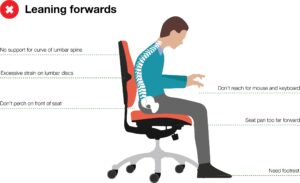Are you sitting comfortably?
Are you sitting comfortably? Then I’ll begin. The osteopaths at Sollus Healthcare see a lot of clients that have work-related aches and pains, especially the ones that work in an office environment.
Work related musculoskeletal disorders (WRMSD), as we professionals like to call them, are the result of a poor work environment affecting muscles, joints and ligaments usually in the neck, shoulders and low back. These problems can seriously affect your quality of life and this can be confirmed by anyone that has suffered from low back pain, neck or shoulder problems or posture-related headaches.
According to the latest statistics (1):
- In 2014/15 44% of work related illnesses were WRMSD.
- An estimated 9.5 million working days were lost due to WRMSD, which is 40% of all days lost due to work related ill-health in 2014/15.
(If you would like to know more, you can have a look at this (1) www.hse.gov.uk/statistics/causdis/musculoskeletal/msd.pdf)
We work with employees based at some of Northampton’s largest educational establishments treating WRMSD and providing advice on workstation setup. Until they came to see us many of these clients didn’t even realise that their workstation set up could have such a significant impact on their physical wellbeing.
Here is some advice on what you can do so you don’t end up with similar problems:

Don’t work like this
Head forward, rounded shoulders & low back, leaning forward with your weight through your elbows, pressure on the wrists etc.
This can result in headaches, neck pain, shoulder pain, tennis elbow, low back pain and wrist pain.

Work like this
Head upright, (top of the monitor level with your eyes), straight back, your bottom at the back of the chair, forearms resting on the desk and feet on the floor (use a foot rest if your feet don’t reach the floor)
Once you have set up your workstation correctly, here are some other things that you should consider:
- Desks are designed for people of average height and if you are very tall you probably need a height adjustable desk. If you are shorter than average and your feet don’t touch the floor when you are sat down you need a footrest (whatever you do don’t tuck your legs under your chair or adopt other strange positions as this can cause hip, low back and knee problems over time!).
- Avoid crossing your legs while sitting.
- At least once an hour look away from the screen and focus on a distant object for 30 secs to reduce eyestrain.
- If you spend a lot of time on the telephone, don’t cradle it in your neck, treat yourself to a headset.
Specialist equipment can be useful e.g. if your work requires a lot of numeric input you could use a numeric keypad and reduce the amount of typing by using voice to text software.
Other things to consider are:
- TAKE REGULAR BREAKS AWAY FROM YOUR DESK!!! (probably the most important point hence the capital letters!)
- Ideally take a minimum 5 minute break from your desk every 30-45 minutes. (set up a reminder on your PC or use the timer app on your phone)
- Rather than emailing or calling someone in your office go and see them.
- Eat your lunch away from your desk and go for a walk afterwards.
- Do some stretches during the break (contact us for exercises ideas if you need to)
If you have a WRMSD caused by office work, doing some or all of the above will definitely help and remember it is equally important to apply the same principles if you work from home.
Don’t forget we offer 15 minute FREE assessments so please contact us if you have any concerns about a pain that just won’t go away or you would like more advice on your desktop setup. You can call us on 01604 532853 or email info@sollushealthcare.co.uk We are here to help.
